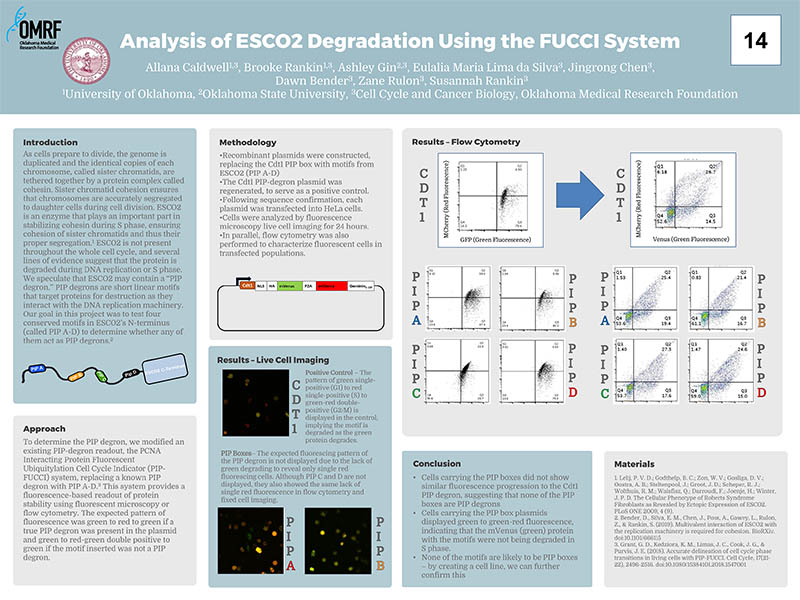
Hover to pan and click to magnify. Click again to pan at full screen.
Allana G. Caldwell, B. Rankin, A. Gin, E. M. Lima da Silva, J. Chen, D. Bender, Z. Rulon and S. Rankin. Dept. of Biology, University of Oklahoma, Norman, OK; Dept. of Cell Cycle and Cancer Biology, Oklahoma Medical Research Foundation, Oklahoma City, OK. Faculty Advisor, Dr. Susannah Rankin, OK Medical Research Foundation, Oklahoma City, OK.
Allana G. Caldwell, B. Rankin, A. Gin, E. M. Lima da Silva, J. Chen, D. Bender, Z. Rulon and S. Rankin. Dept. of Biology, University of Oklahoma, Norman, OK; Dept. of Cell Cycle and Cancer Biology, Oklahoma Medical Research Foundation, Oklahoma City, OK. Faculty Advisor, Dr. Susannah Rankin, OK Medical Research Foundation, Oklahoma City, OK.
ABSTRACT
Many proteins interact with cohesin to ensure the accurate alignment and segregation of sister chromatids during cell division. One of these proteins, the Establishment of Sister Chromatid Cohesion N-Acetyltransferase 2 protein (ESCO2), acetylates the SMC3 subunit of cohesin, which is essential for cohesion between the sister chromatids. Expression of Esco2 drops during S phase and previous research suggests that ESCO2 is subject to the CUL4 degradation pathway. Substrates of this pathway are degraded following the interaction of certain motifs with the Proliferating Cell Nuclear Antigen (PCNA). These motifs are called PCNA interacting protein motifs, or PIP boxes for short. PIP boxes that target the protein for degradation are referred to as PIP degrons. Four potential PIP boxes that are strongly conserved in ESCO2 gene were analyzed to determine whether they promote ESCO2 degradation by Cul4. To do this, we modified a cell cycle indicating plasmid, the PCNA Interacting Protein-Fluorescent Ubiquitination-based Cell Cycle Indicator (PIP-FUCCI) system, in which a known PIP degron Cdt1 is fused to the mVenus fluorescent protein. We replaced the Cdt1 degron with the sequences of interest from ESCO2 (referred to as PIP A through PIP D) and introduced these plasmids into HeLa cells. The cells were analyzed utilizing live cell imaging and flow cytometry. The fluorescent tags encoded by the recombinant plasmids were used as indicators for the stages of the cell cycle and were fused to the potential degrons. We propose that none of the PIP boxes act as PIP degrons due to the mVenus tag in our plasmid not degrading during the S phase of the cell cycle during both live cell imaging and flow cytometry, an indicator that the PIP boxes of interest were also unable to degrade during S phase. We are better able to understand the cell cycle and cohesion of sister chromatids by analyzing ESCO2 for potential PIP degrons. This research can also allow us to better understand the function of ESCO2, which plays an important role in several rare genetic disorders including Roberts Syndrome (RBS) and Sc Phocomelia Syndrome (SCPS).

DISQUS COMMENTS WILL BE SHOWN ONLY WHEN YOUR SITE IS ONLINE